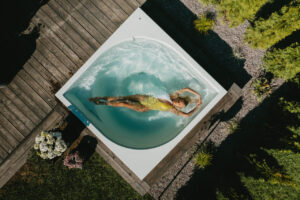The bath barrel - an ancient healer
 First information jthe Apanish bath, or furodate back to the 13th century, when the Japanese were inspired by hot springs and the ancient tradition of relaxing in them. Now hot tubs are taking over the world.
First information jthe Apanish bath, or furodate back to the 13th century, when the Japanese were inspired by hot springs and the ancient tradition of relaxing in them. Now hot tubs are taking over the world.
What makes Furo special is that it works with hot water instead of hot air. It is safer for people with joint and muscle problems. Japanese baths are also an excellent alternative to natural hot springs, which unfortunately not everyone can enjoy.
However, since time immemorial, it has been a tradition in Japan to relax in a hot spring and seek health from it. This tradition became a business model in Japan centuries ago - holiday homes were built around hot springs, where people could enjoy the pleasures of hot water to improve their health.
More luxurious holiday homes were built on top of the fountains to provide greater comfort and privacy for wealthier guests. This tradition is still valued by the Japanese and many family holidays are planned specifically near hot springs. It is also almost impossible to travel in Japan without enjoying the pleasures of the hot springs.
Furo - mood creator
However, people love comfort, and they also wanted to relax at home. The Japanese, not to be disturbed by the location of hot springs, invented the furo - the heated bathtub.
The Japanese bath is a mood-creator that refreshes both body and mind, providing a pleasant pastime. The water temperature of a Japanese bath is traditionally between 40 and 42 degrees Celsius and relaxation in hot water could last 20 minutes. The warmth from the water stays in the body for a long time and the relaxation is followed by a pleasant feeling of calm.
In addition to relaxation, the Japanese bath has a great effect on the circulation of the whole body, speeding up the metabolism and eliminating toxins from the body, which also makes the skin more beautiful. Whereas in the traditional Finnish sauna, the body is detoxified by the sometimes breathtaking steam, in the Japanese bath, it is the relaxing hot water which, as already mentioned, is safer for the joints and muscles.
Perhaps the reason for the high life expectancy of the Japanese lies in their hot springs culture, with current projections suggesting that half of Japanese people born in 2007 will live to the age of 107.
Bath barrels - handmade tailor-made solutions
 Lingalaid bath barrels are Japanese bath tubs, handmade in Estonia, with a size, heater and style of your choice. Available for 2-3 people or for a large party, the choice is yours.
Lingalaid bath barrels are Japanese bath tubs, handmade in Estonia, with a size, heater and style of your choice. Available for 2-3 people or for a large party, the choice is yours.
The Lingalaid's bath barrels can hold between 1100 and 2000 litres of water, heated by either wood or electric heating.
There's plenty to enjoy all year round - on summer evenings and crisp frosty days alike. The hot tub combines the pleasant with the beneficial by relaxing muscles, stimulating circulation and managing stress, and when you add to that the pleasure of company, it's hard to find a more enjoyable way to spend time.
A hot tub is not for washing, but for grooming, relaxing and enjoying company. Usually, in a Japanese bath, relaxation is preceded by a full-body wash as a tribute to both oneself and the other guests. Various salts and minerals may also be added to the water, according to the preferences of the company, to further refresh the body and mind.